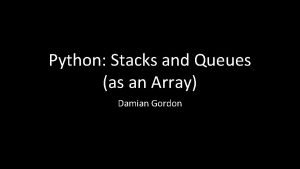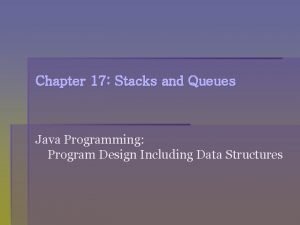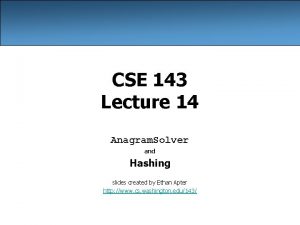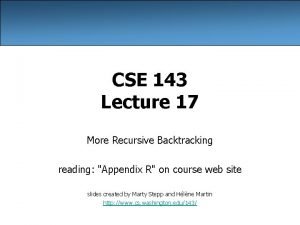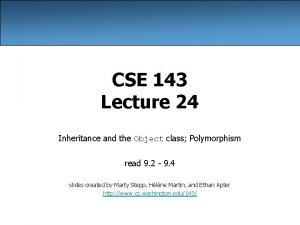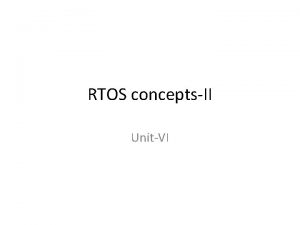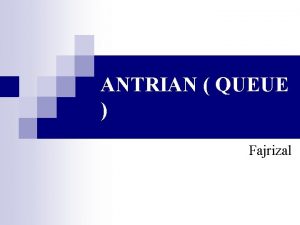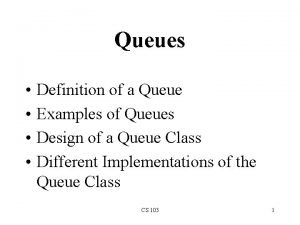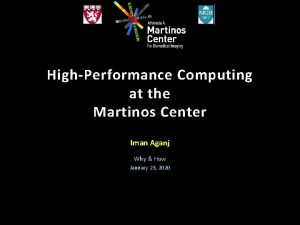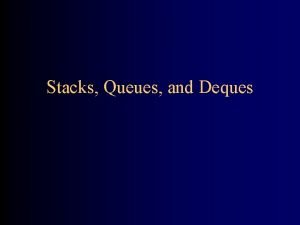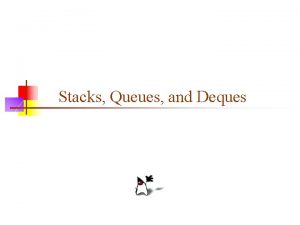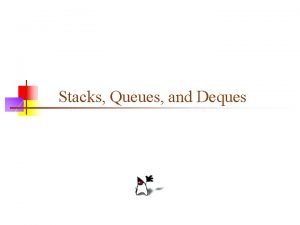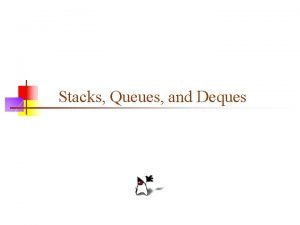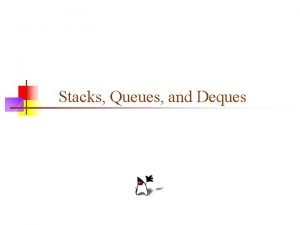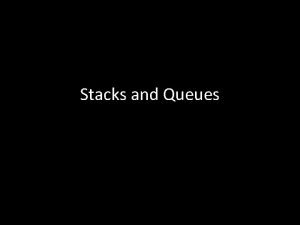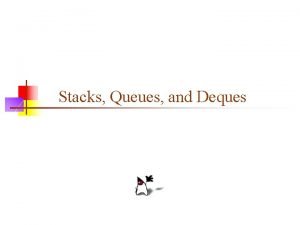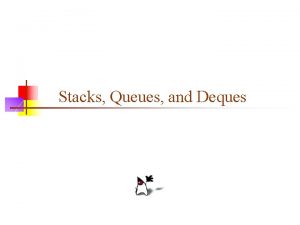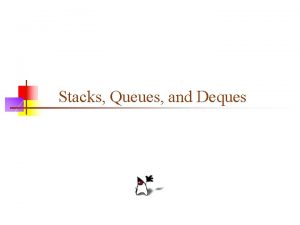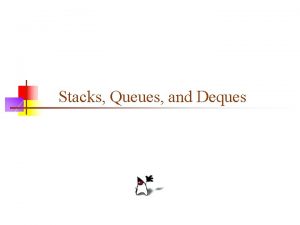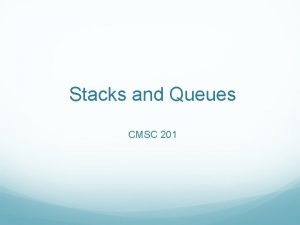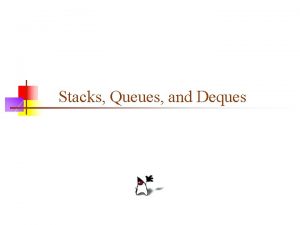CSE 143 Lecture 4 Stacks and Queues Stacks















- Slides: 15

CSE 143 Lecture 4: Stacks and Queues

Stacks and queues • Sometimes it is good to have a collection that is less powerful, but is optimized to perform certain operations very quickly. • Today we will examine two specialty collections: – stack: Retrieves elements in the reverse of the order they were added. – queue: Retrieves elements in the same order they were added. push top pop, peek 3 2 bottom 1 remove, peek front 1 back 2 3 add queue stack 2

Abstract data types (ADTs) • abstract data type (ADT): A specification of a collection of data and the operations that can be performed on it. – Describes what a collection does, not how it does it • We don't know exactly how a stack or queue is implemented, and we don't need to. – We just need to understand the idea of the collection and what operations it can perform. (Stacks are usually implemented with arrays; queues are often implemented using another structure called a linked list. ) 3

Stacks • stack: A collection based on the principle of adding elements and retrieving them in the opposite order. – Last-In, First-Out ("LIFO") – The elements are stored in order of insertion, but we do not think of them as having indexes. – The client can only add/remove/examine the last element added (the "top"). push pop, peek • basic stack operations: – push: Add an element to the top. – pop: Remove the top element. – peek: Examine the top element. top 3 2 bottom 1 stack 4

Stacks in computer science • Programming languages and compilers: – method calls are placed onto a stack (call=push, return=pop) – compilers use stacks to evaluate expressions • Matching up related pairs of things: – find out whether a string is a palindrome – examine a file to see if its braces { } match – convert "infix" expressions to pre/postfix method 3 return var local vars parameters method 2 return var local vars parameters method 1 return var local vars parameters • Sophisticated algorithms: – searching through a maze with "backtracking" – many programs use an "undo stack" of previous operations 5

Class Stack<E>() constructs a new stack with elements of type E push(value) places given value on top of stack pop() removes top value from stack and returns it; throws Empty. Stack. Exception if stack is empty peek() returns top value from stack without removing it; throws Empty. Stack. Exception if stack is empty size() returns number of elements in stack is. Empty() returns true if stack has no elements Stack<Integer> s = new Stack<Integer>(); s. push(42); s. push(-3); s. push(17); // bottom [42, -3, 17] top System. out. println(s. pop()); // 17 – Stack has other methods, but we forbid you to use them. 6

Stack limitations/idioms • Remember: You cannot loop over a stack in the usual way. Stack<Integer> s = new Stack<Integer>(); . . . for (int i = 0; i < s. size(); i++) { do something with s. get(i); } • Instead, you must pull contents out of the stack to view them. – common idiom: Removing each element until the stack is empty. // process (and destroy) an entire stack while (!s. is. Empty()) { do something with s. pop(); } 7

Exercise • Consider an input file of exam scores in reverse ABC order: Woods Van. Hofwegen Rhodehamel Pendleton. . . Vivyan Raquel Derek Anna 64 92 95 87 • Write code to print the exam scores in ABC order using a stack. – What if we want to further process the exams after printing? 8

Queues • queue: Retrieves elements in the order they were added. – First-In, First-Out ("FIFO") – Elements are stored in order of insertion but don't have indexes. – Client can only add to the end of the queue, and can only examine/remove the front of the queue. remove, peek front 1 • basic queue operations: back 2 3 add queue – add (enqueue): Add an element to the back. – remove (dequeue): Remove the front element. – peek: Examine the front element. 11

Queues in computer science • Operating systems: – queue of print jobs to send to the printer – queue of programs / processes to be run – queue of network data packets to send • Programming: – modeling a line of customers or clients – storing a queue of computations to be performed in order • Real world examples: – people on an escalator or waiting in a line – cars at a gas station (or on an assembly line) 12

Programming with Queues add(value) places given value at back of queue remove() removes value from front of queue and returns it; throws a No. Such. Element. Exception if queue is empty peek() returns front value from queue without removing it; returns null if queue is empty size() returns number of elements in queue is. Empty() returns true if queue has no elements Queue<Integer> q = new Linked. List<Integer>(); q. add(42); q. add(-3); q. add(17); // front [42, -3, 17] back System. out. println(q. remove()); // 42 – IMPORTANT: When constructing a queue you must use a new Linked. List object instead of a new Queue object. • This has to do with a topic we'll discuss later called interfaces. 13

Queue idioms • As with stacks, must pull contents out of queue to view them. // process (and destroy) an entire queue while (!q. is. Empty()) { do something with q. remove(); } – another idiom: Examining each element exactly once. int size = q. size(); for (int i = 0; i < size; i++) { do something with q. remove(); (including possibly re-adding it to the queue) } • Why do we need the size variable? 14

Mixing stacks and queues • We often mix stacks and queues to achieve certain effects. – Example: Reverse the order of the elements of a queue. Queue<Integer> q = new Linked. List<Integer>(); q. add(1); q. add(2); q. add(3); // [1, 2, 3] Stack<Integer> s = new Stack<Integer>(); while (!q. is. Empty()) { // Q -> S s. push(q. remove()); } while (!s. is. Empty()) { // S -> Q q. add(s. pop()); } System. out. println(q); // [3, 2, 1] 15

Exercise • Modify our exam score program so that it reads the exam scores into a queue and prints the queue. – Next, filter out any exams where the student got a score of 100. – Then perform your previous code of reversing and printing the remaining students. • What if we want to further process the exams after printing? 16

Exercises • Write a method stutter that accepts a queue of integers as a parameter and replaces every element of the queue with two copies of that element. – front [1, 2, 3] back becomes front [1, 1, 2, 2, 3, 3] back • Write a method mirror that accepts a queue of strings as a parameter and appends the queue's contents to itself in reverse order. – front [a, b, c] back becomes front [a, b, c, c, b, a] back 17
